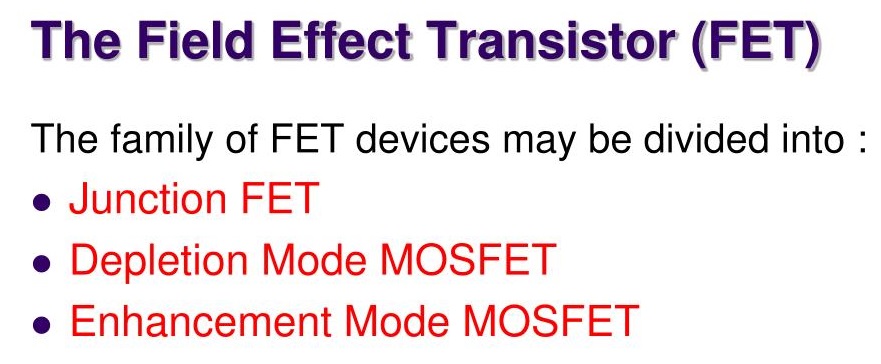Field-effect transistors (FETs) are another type of transistor commonly used in electronic circuits. Unlike bipolar junction transistors (BJTs), FETs rely on the modulation of the conductivity of semiconductor material by an electric field, rather than the injection of charge carriers from one region to another.
Field-effect transistors (FETs)

FETs consist of three terminals: the source, gate, and drain. The gate is separated from the semiconductor material (channel) by a thin insulating layer (oxide). The semiconductor material can be n-type or p-type, depending on the type of FET. When a voltage is applied to the gate terminal, it creates an electric field that controls the flow of charge carriers through the channel between the source and drain terminals.
There are two main types of FETs: junction field-effect transistors (JFETs) and metal-oxide-semiconductor field-effect transistors (MOSFETs). In a JFET, the channel is a single, continuous region of semiconductor material, and the gate forms a p-n junction with the channel. When a voltage is applied to the gate, it modulates the width of the depletion region around the p-n junction, which in turn controls the flow of charge carriers through the channel.
In a MOSFET, the gate is separated from the channel by a thin layer of insulating material, typically silicon dioxide (SiO2). The gate is usually made of metal, and the channel is a doped semiconductor material, usually silicon. When a voltage is applied to the gate, it creates an electric field that attracts or repels charge carriers in the channel, modulating the conductivity of the channel.
MOSFETs are widely used in modern electronics due to their high input impedance, low output impedance, and ability to switch high currents with low gate currents. They are commonly used in digital circuits, such as microprocessors and memory chips. JFETs are less common but still used in certain applications, such as amplifiers and voltage regulators.
Working Of Field-effect transistors (FETs)
Field-effect transistors (FETs) are electronic devices that work by controlling the flow of charge carriers through a semiconductor channel using an electric field. There are two main types of FETs: junction field-effect transistors (JFETs) and metal-oxide-semiconductor field-effect transistors (MOSFETs).
JFETs have a single, continuous semiconductor channel between the source and drain terminals, with a p-n junction formed by the gate terminal. When a voltage is applied to the gate, it creates an electric field that modulates the width of the depletion region around the p-n junction, which in turn controls the flow of charge carriers through the channel. The depletion region is a region in the channel where there are no charge carriers due to the repelling electric field of the gate, which reduces the conductivity of the channel.
MOSFETs have a thin layer of insulating material (usually silicon dioxide) between the gate and the semiconductor channel. When a voltage is applied to the gate, it creates an electric field that attracts or repels charge carriers in the channel, modulating the conductivity of the channel. MOSFETs can be either n-type or p-type, depending on the type of semiconductor material used for the channel.
The operation of a MOSFET can be further classified into two types: enhancement-mode MOSFETs and depletion-mode MOSFETs. Enhancement-mode MOSFETs require a positive voltage applied to the gate to create an inversion layer of charge carriers in the channel, which enhances the conductivity of the channel. Depletion-mode MOSFETs, on the other hand, have a thin layer of n-type or p-type semiconductor material near the gate, which forms a depletion region that reduces the conductivity of the channel. A negative voltage applied to the gate attracts more charge carriers into the depletion region, further reducing the conductivity of the channel.
FETs are widely used in various electronic applications, including amplifiers, switches, and digital circuits. They are known for their high input impedance, low output impedance, and low power consumption.
Types of Field-effect transistors (FETs)
There are two main types of field-effect transistors (FETs): junction field-effect transistors (JFETs) and metal-oxide-semiconductor field-effect transistors (MOSFETs).
JFETs have a single, continuous semiconductor channel between the source and drain terminals, with a p-n junction formed by the gate terminal. JFETs can be either n-channel or p-channel, depending on the type of semiconductor material used for the channel.
MOSFETs have a thin layer of insulating material (usually silicon dioxide) between the gate and the semiconductor channel. MOSFETs can be further classified into two types based on their operation: enhancement-mode MOSFETs and depletion-mode MOSFETs.
Enhancement-mode MOSFETs require a positive voltage applied to the gate to create an inversion layer of charge carriers in the channel, which enhances the conductivity of the channel. Enhancement-mode MOSFETs can be either n-channel or p-channel, depending on the type of semiconductor material used for the channel.
Depletion-mode MOSFETs, on the other hand, have a thin layer of n-type or p-type semiconductor material near the gate, which forms a depletion region that reduces the conductivity of the channel. A negative voltage applied to the gate attracts more charge carriers into the depletion region, further reducing the conductivity of the channel. Depletion-mode MOSFETs can also be either n-channel or p-channel.
In addition to JFETs and MOSFETs, there are other types of FETs, such as insulated-gate bipolar transistors (IGBTs), junction-gate field-effect transistors (JGFETs), and heterojunction field-effect transistors (HFETs). However, these types of FETs are less commonly used compared to JFETs and MOSFETs.